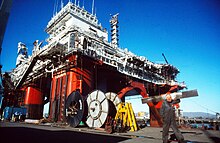
An oil platform is a large structure with facilities to extract and process petroleum and natural gas that lie in rock formations beneath the seabed. Many oil platforms will also have facilities to accommodate the workers, although it is also common to have a separate accommodation platform bridge linked to the production platform. Most commonly, oil platforms engage in activities on the continental shelf, though they can also be used in lakes, inshore waters, and inland seas. Depending on the circumstances, the platform may be fixed to the ocean floor, consist of an artificial island, or float. In some arrangements the main facility may have storage facilities for the processed oil. Remote subsea wells may also be connected to a platform by flow lines and by umbilical connections. These sub-sea facilities may include of one or more subsea wells or manifold centres for multiple wells.

Offshore construction is the installation of structures and facilities in a marine environment, usually for the production and transmission of electricity, oil, gas and other resources. It is also called maritime engineering.
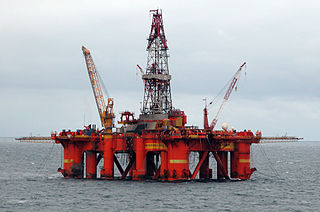
A semi-submersible platform is a specialised marine vessel used in offshore roles including as offshore drilling rigs, safety vessels, oil production platforms, and heavy lift cranes. They have good ship stability and seakeeping, better than drillships.

A floating production storage and offloading (FPSO) unit is a floating vessel used by the offshore oil and gas industry for the production and processing of hydrocarbons, and for the storage of oil. An FPSO vessel is designed to receive hydrocarbons produced by itself or from nearby platforms or subsea template, process them, and store oil until it can be offloaded onto a tanker or, less frequently, transported through a pipeline. FPSOs are preferred in frontier offshore regions as they are easy to install, and do not require a local pipeline infrastructure to export oil. FPSOs can be a conversion of an oil tanker or can be a vessel built specially for the application. A vessel used only to store oil is referred to as a floating storage and offloading (FSO) vessel.

A diving support vessel is a ship that is used as a floating base for professional diving projects. Basic requirements are the ability to keep station accurately and reliably throughout a diving operation, often in close proximity to drilling or production platforms, for positioning to degrade slowly enough in deteriorating conditions to recover divers without excessive risk, and to carry the necessary support equipment for the mode of diving to be used.

MSV Fennica is a Finnish multipurpose icebreaker and offshore support vessel. Built in 1993 by Finnyards in Rauma, Finland and operated by Arctia Offshore, she was the first Finnish icebreaker designed to be used as an escort icebreaker in the Baltic Sea during the winter months and in offshore construction projects during the open water season. Fennica has an identical sister ship, Nordica, built in 1994.

Byford Dolphin was a semi-submersible, column-stabilised drilling rig operated by Dolphin Drilling, a Fred Olsen Energy subsidiary. It drilled seasonally for various companies in the United Kingdom, Danish and Norwegian sectors of the North Sea. It was registered in Hamilton, Bermuda.

The Saipem 7000 is the world's third largest semi-submersible crane vessel, after the SSCV Sleipnir and the SSCV Thialf. It is owned by the oil and gas industry contractor Saipem S.p.A.
SCF Sakhalin is a Russian icebreaking platform supply and standby vessel owned by SCF Sakhalin Vessels Limited, a subsidiary of Sovcomflot. The ship was built by Aker Finnyards Helsinki shipyard in Finland in 2005 as FESCO Sakhalin for Far East Shipping Company (FESCO), but was purchased by Sovcomflot and renamed in 2010. Since the beginning it has been in long-term charter for Exxon Neftegas Ltd. and used to supply oil platforms in the Sakhalin-I project.

Polar Class (PC) refers to the ice class assigned to a ship by a classification society based on the Unified Requirements for Polar Class Ships developed by the International Association of Classification Societies (IACS). Seven Polar Classes are defined in the rules, ranging from PC 1 for year-round operation in all polar waters to PC 7 for summer and autumn operation in thin first-year ice.
Offshore concrete structures have been in use successfully for about 50 years. They serve the same purpose as their steel counterparts in the oil and gas production and storage. The first concrete oil platform has been installed in the North Sea in the Ekofisk field in 1973 by Phillips Petroleum. Since then 47 major concrete offshore structures have been built.

The FPSO Noble Seillean was a dynamically positioned floating oil production, storage and offloading vessel.

Q4000 is a multi-purpose oil field construction and intervention vessel ordered in 1999 by Cal Dive International, and was built at the Keppel AmFELS shipyard in Brownsville, Texas for $180 million. She was delivered in 2002 and operates under the flag of the United States. She is operated by Helix Energy Solutions Group. The original Q4000 concept was conceived and is owned by SPD/McClure. The design was later modified by Bennett Offshore, which was selected to develop both the basic and detailed design.
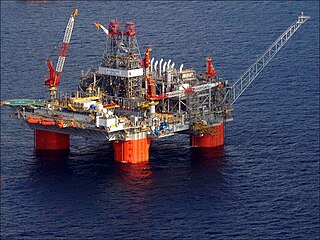
Thunder Horse PDQ is a BP plc and ExxonMobil joint venture semi-submersible oil platform on location over the Mississippi Canyon Thunder Horse oil field, in deepwater Gulf of Mexico, 150 miles (240 km) southeast of New Orleans, moored in waters of 1,840 metres (6,040 ft). The "PDQ" identifies the platform as being a Production and oil Drilling facility with crew Quarters.

Helix Energy Solutions Inc., known as Cal Dive International prior to 2006, is an American oil and gas services company headquartered in Houston, Texas. The company is a global provider of offshore services in well intervention and ROV operations of new and existing oil and gas fields.
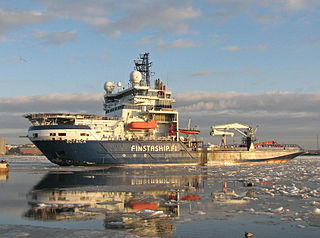
MSV Botnica is a multipurpose offshore support vessel and icebreaker built by Finnyards in Rauma, Finland, in 1998. She was the newest and technically most advanced state-owned icebreaker of Finland until 2012, when she was sold to the Port of Tallinn for 50 million euro. Botnica is used as an escort icebreaker in the Baltic Sea during the winter months, but carries out subsea and offshore construction works worldwide during the open water season.

Commercial offshore diving, sometimes shortened to just offshore diving, generally refers to the branch of commercial diving, with divers working in support of the exploration and production sector of the oil and gas industry in places such as the Gulf of Mexico in the United States, the North Sea in the United Kingdom and Norway, and along the coast of Brazil. The work in this area of the industry includes maintenance of oil platforms and the building of underwater structures. In this context "offshore" implies that the diving work is done outside of national boundaries. Technically it also refers to any diving done in the international offshore waters outside of the territorial waters of a state, where national legislation does not apply. Most commercial offshore diving is in the Exclusive Economic Zone of a state, and much of it is outside the territorial waters. Offshore diving beyond the EEZ does also occur, and is often for scientific purposes.

MSV Nordica is a Finnish multipurpose icebreaker and offshore support vessel. Built in 1994 by Finnyards in Rauma, Finland, and operated by Arctia Offshore, she and her sister ship Fennica were the first Finnish icebreakers designed to be used as escort icebreakers in the Baltic Sea during the winter months and in offshore construction projects during the open water season.
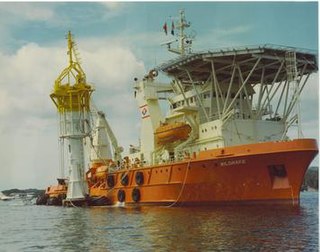
The Wildrake diving accident was an incident in Scotland in August 1979 that killed two American commercial divers. During a routine dive in the East Shetland Basin of the North Sea, the diving bell of the diving support vessel MS Wildrake became separated from its main lift wire at a depth of over 160 metres (520 ft). Although the bell was eventually recovered by Wildrake, its two occupants, 32-year-old Richard Arthur Walker and 28-year-old Victor Francis "Skip" Guiel Jr., died of hypothermia. The accident resulted in extensive subsequent litigation and led to important safety changes in the diving industry.

The Neptuno is a semi-submersible accommodation vessel.


